Innovative Companies and Competitive Advantage in Renewable Energy
VerifiedAdded on 2021/01/06
|73
|24494
|47
Report
AI Summary
This report, authored by Rajesh Anand, investigates how innovative companies in the United States gain a competitive advantage by effectively managing renewable energy technologies. The study focuses on wind, solar photovoltaic (PV), and concentrating solar power (CSP) technologies, analyzing their potential for mitigating the energy crisis, creating jobs, and boosting the economy. The research includes semi-structured interviews with management personnel from ten U.S. renewable energy companies, providing bottom-up data on market dynamics and industry trends. The findings highlight the importance of R&D investments and regulatory frameworks for companies seeking a competitive edge, while also acknowledging the challenges posed by emerging market competitors. The report covers literature review, research methodology, findings, data analysis, and recommendations, offering insights into the current situation, lead markets, and diffusion of photovoltaic systems.
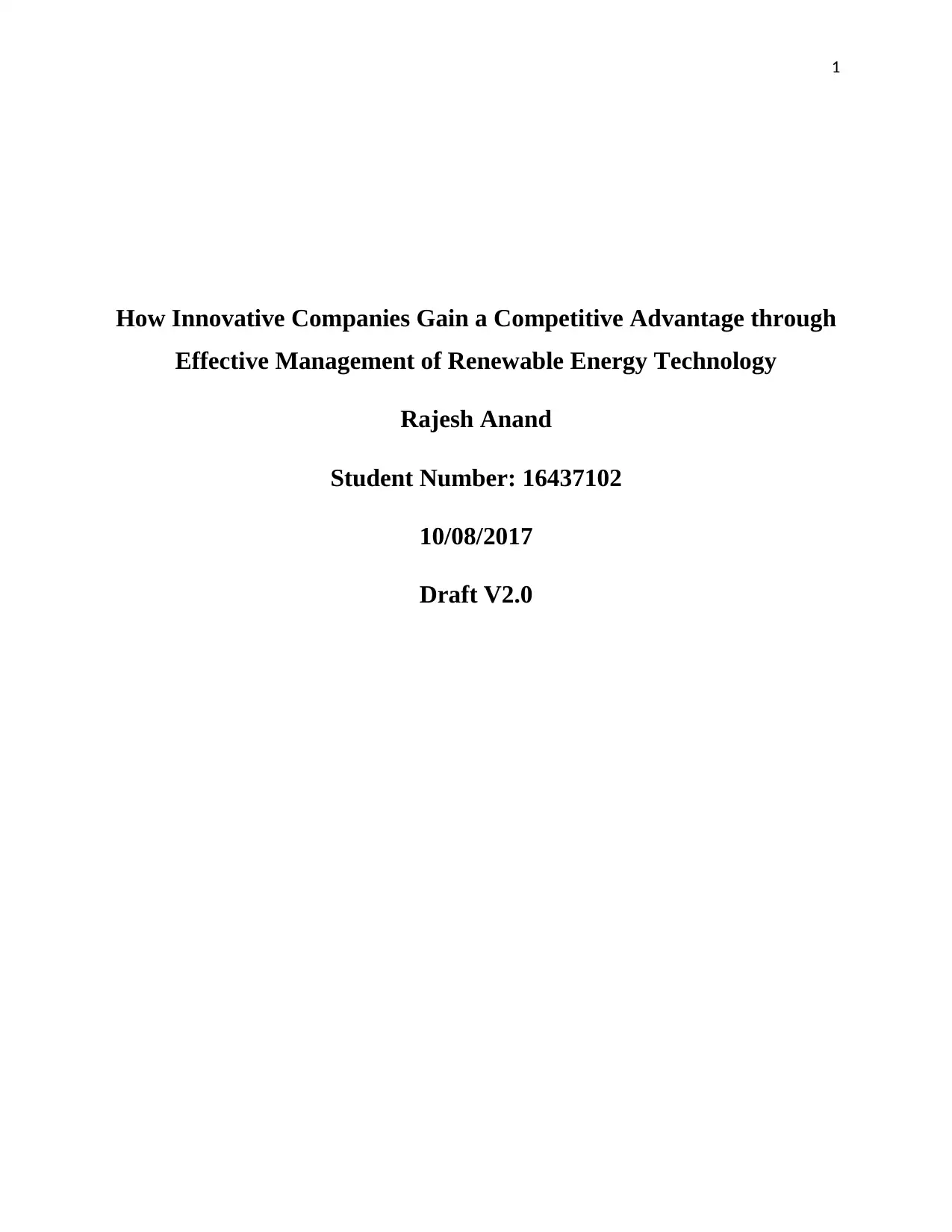
1
How Innovative Companies Gain a Competitive Advantage through
Effective Management of Renewable Energy Technology
Rajesh Anand
Student Number: 16437102
10/08/2017
Draft V2.0
How Innovative Companies Gain a Competitive Advantage through
Effective Management of Renewable Energy Technology
Rajesh Anand
Student Number: 16437102
10/08/2017
Draft V2.0
Paraphrase This Document
Need a fresh take? Get an instant paraphrase of this document with our AI Paraphraser

Page | 2
ACKNOLWEDGEMENT
This research study was supported by my professor and dissertation supervisor Dr.Nick Barnes. I
would like to thank him for his valuable and professional guidance and insight also like to thank
all my colleagues from Signature One INC, United States who helped me by providing insight
and expertise that immensely assisted the research and gather the information required and
introducing to the right faculties and helping me making the right connections in the industry. A
special thanks to the team who have extended support on the virtual medium and calls to
facilitate sessions with multiple industry leaders and subject matter experts in the United States.
ACKNOLWEDGEMENT
This research study was supported by my professor and dissertation supervisor Dr.Nick Barnes. I
would like to thank him for his valuable and professional guidance and insight also like to thank
all my colleagues from Signature One INC, United States who helped me by providing insight
and expertise that immensely assisted the research and gather the information required and
introducing to the right faculties and helping me making the right connections in the industry. A
special thanks to the team who have extended support on the virtual medium and calls to
facilitate sessions with multiple industry leaders and subject matter experts in the United States.
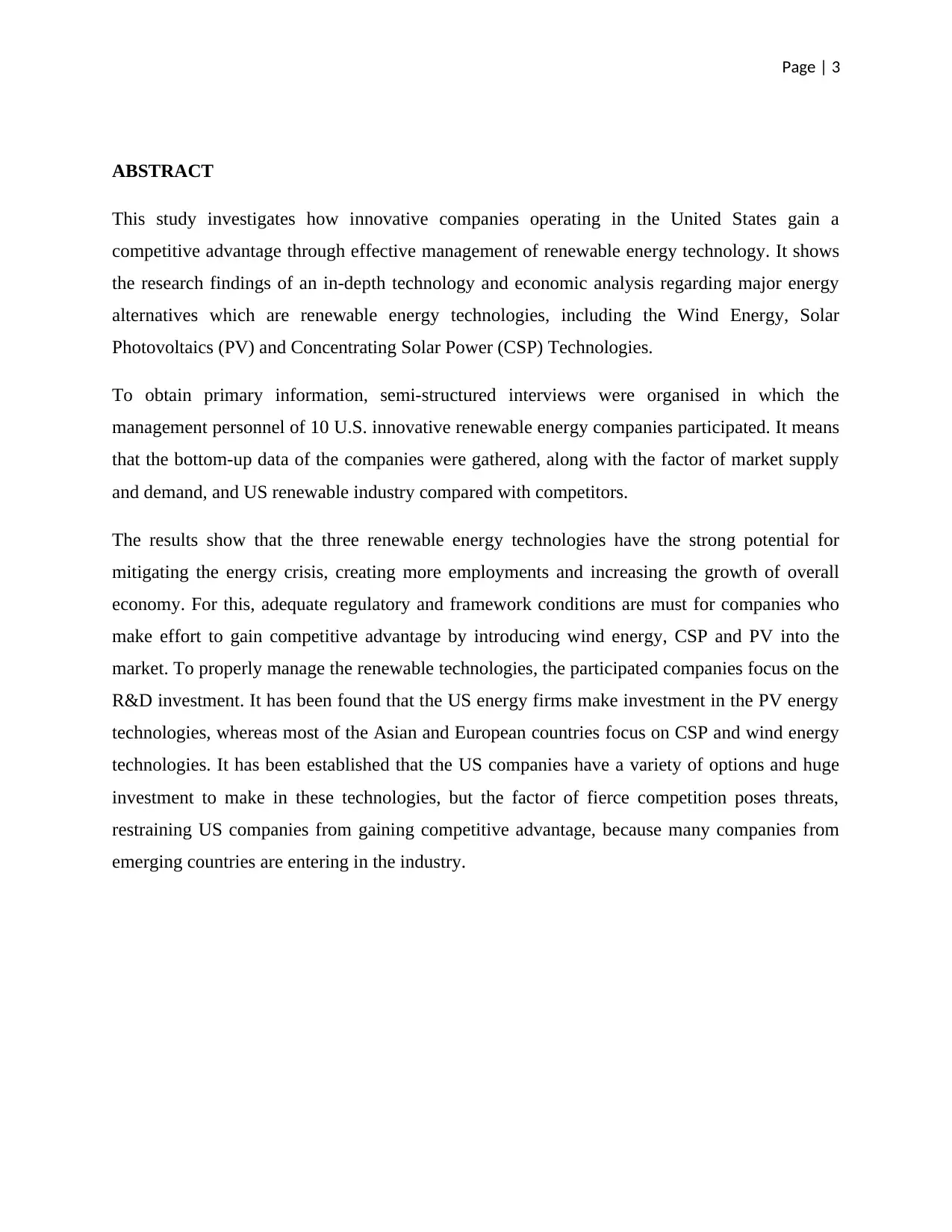
Page | 3
ABSTRACT
This study investigates how innovative companies operating in the United States gain a
competitive advantage through effective management of renewable energy technology. It shows
the research findings of an in-depth technology and economic analysis regarding major energy
alternatives which are renewable energy technologies, including the Wind Energy, Solar
Photovoltaics (PV) and Concentrating Solar Power (CSP) Technologies.
To obtain primary information, semi-structured interviews were organised in which the
management personnel of 10 U.S. innovative renewable energy companies participated. It means
that the bottom-up data of the companies were gathered, along with the factor of market supply
and demand, and US renewable industry compared with competitors.
The results show that the three renewable energy technologies have the strong potential for
mitigating the energy crisis, creating more employments and increasing the growth of overall
economy. For this, adequate regulatory and framework conditions are must for companies who
make effort to gain competitive advantage by introducing wind energy, CSP and PV into the
market. To properly manage the renewable technologies, the participated companies focus on the
R&D investment. It has been found that the US energy firms make investment in the PV energy
technologies, whereas most of the Asian and European countries focus on CSP and wind energy
technologies. It has been established that the US companies have a variety of options and huge
investment to make in these technologies, but the factor of fierce competition poses threats,
restraining US companies from gaining competitive advantage, because many companies from
emerging countries are entering in the industry.
ABSTRACT
This study investigates how innovative companies operating in the United States gain a
competitive advantage through effective management of renewable energy technology. It shows
the research findings of an in-depth technology and economic analysis regarding major energy
alternatives which are renewable energy technologies, including the Wind Energy, Solar
Photovoltaics (PV) and Concentrating Solar Power (CSP) Technologies.
To obtain primary information, semi-structured interviews were organised in which the
management personnel of 10 U.S. innovative renewable energy companies participated. It means
that the bottom-up data of the companies were gathered, along with the factor of market supply
and demand, and US renewable industry compared with competitors.
The results show that the three renewable energy technologies have the strong potential for
mitigating the energy crisis, creating more employments and increasing the growth of overall
economy. For this, adequate regulatory and framework conditions are must for companies who
make effort to gain competitive advantage by introducing wind energy, CSP and PV into the
market. To properly manage the renewable technologies, the participated companies focus on the
R&D investment. It has been found that the US energy firms make investment in the PV energy
technologies, whereas most of the Asian and European countries focus on CSP and wind energy
technologies. It has been established that the US companies have a variety of options and huge
investment to make in these technologies, but the factor of fierce competition poses threats,
restraining US companies from gaining competitive advantage, because many companies from
emerging countries are entering in the industry.
⊘ This is a preview!⊘
Do you want full access?
Subscribe today to unlock all pages.

Trusted by 1+ million students worldwide
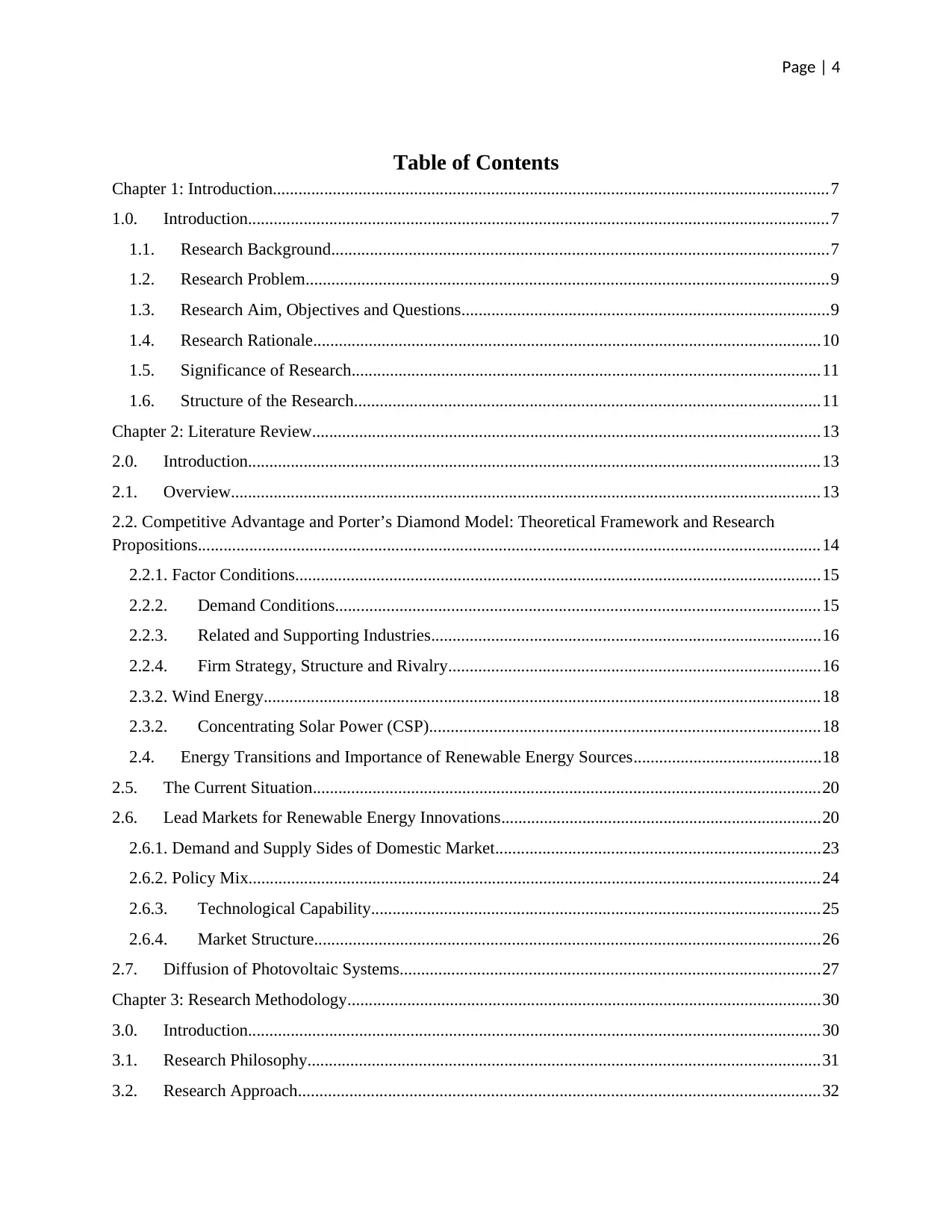
Page | 4
Table of Contents
Chapter 1: Introduction..................................................................................................................................7
1.0. Introduction........................................................................................................................................7
1.1. Research Background....................................................................................................................7
1.2. Research Problem..........................................................................................................................9
1.3. Research Aim, Objectives and Questions......................................................................................9
1.4. Research Rationale.......................................................................................................................10
1.5. Significance of Research..............................................................................................................11
1.6. Structure of the Research.............................................................................................................11
Chapter 2: Literature Review.......................................................................................................................13
2.0. Introduction......................................................................................................................................13
2.1. Overview..........................................................................................................................................13
2.2. Competitive Advantage and Porter’s Diamond Model: Theoretical Framework and Research
Propositions.................................................................................................................................................14
2.2.1. Factor Conditions...........................................................................................................................15
2.2.2. Demand Conditions.................................................................................................................15
2.2.3. Related and Supporting Industries...........................................................................................16
2.2.4. Firm Strategy, Structure and Rivalry.......................................................................................16
2.3.2. Wind Energy..................................................................................................................................18
2.3.2. Concentrating Solar Power (CSP)...........................................................................................18
2.4. Energy Transitions and Importance of Renewable Energy Sources............................................18
2.5. The Current Situation.......................................................................................................................20
2.6. Lead Markets for Renewable Energy Innovations...........................................................................20
2.6.1. Demand and Supply Sides of Domestic Market............................................................................23
2.6.2. Policy Mix......................................................................................................................................24
2.6.3. Technological Capability.........................................................................................................25
2.6.4. Market Structure......................................................................................................................26
2.7. Diffusion of Photovoltaic Systems..................................................................................................27
Chapter 3: Research Methodology...............................................................................................................30
3.0. Introduction......................................................................................................................................30
3.1. Research Philosophy........................................................................................................................31
3.2. Research Approach..........................................................................................................................32
Table of Contents
Chapter 1: Introduction..................................................................................................................................7
1.0. Introduction........................................................................................................................................7
1.1. Research Background....................................................................................................................7
1.2. Research Problem..........................................................................................................................9
1.3. Research Aim, Objectives and Questions......................................................................................9
1.4. Research Rationale.......................................................................................................................10
1.5. Significance of Research..............................................................................................................11
1.6. Structure of the Research.............................................................................................................11
Chapter 2: Literature Review.......................................................................................................................13
2.0. Introduction......................................................................................................................................13
2.1. Overview..........................................................................................................................................13
2.2. Competitive Advantage and Porter’s Diamond Model: Theoretical Framework and Research
Propositions.................................................................................................................................................14
2.2.1. Factor Conditions...........................................................................................................................15
2.2.2. Demand Conditions.................................................................................................................15
2.2.3. Related and Supporting Industries...........................................................................................16
2.2.4. Firm Strategy, Structure and Rivalry.......................................................................................16
2.3.2. Wind Energy..................................................................................................................................18
2.3.2. Concentrating Solar Power (CSP)...........................................................................................18
2.4. Energy Transitions and Importance of Renewable Energy Sources............................................18
2.5. The Current Situation.......................................................................................................................20
2.6. Lead Markets for Renewable Energy Innovations...........................................................................20
2.6.1. Demand and Supply Sides of Domestic Market............................................................................23
2.6.2. Policy Mix......................................................................................................................................24
2.6.3. Technological Capability.........................................................................................................25
2.6.4. Market Structure......................................................................................................................26
2.7. Diffusion of Photovoltaic Systems..................................................................................................27
Chapter 3: Research Methodology...............................................................................................................30
3.0. Introduction......................................................................................................................................30
3.1. Research Philosophy........................................................................................................................31
3.2. Research Approach..........................................................................................................................32
Paraphrase This Document
Need a fresh take? Get an instant paraphrase of this document with our AI Paraphraser
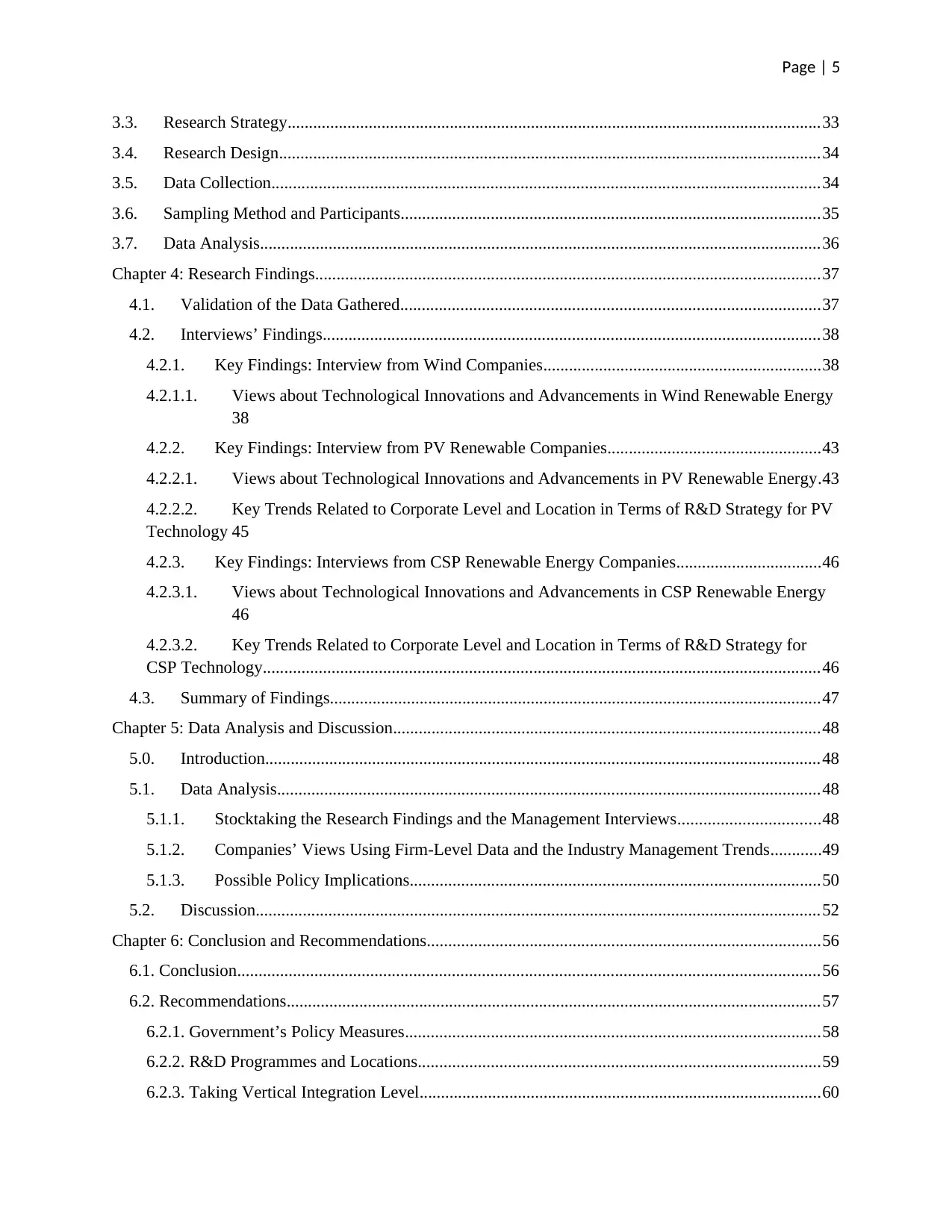
Page | 5
3.3. Research Strategy.............................................................................................................................33
3.4. Research Design...............................................................................................................................34
3.5. Data Collection................................................................................................................................34
3.6. Sampling Method and Participants..................................................................................................35
3.7. Data Analysis...................................................................................................................................36
Chapter 4: Research Findings......................................................................................................................37
4.1. Validation of the Data Gathered..................................................................................................37
4.2. Interviews’ Findings....................................................................................................................38
4.2.1. Key Findings: Interview from Wind Companies.................................................................38
4.2.1.1. Views about Technological Innovations and Advancements in Wind Renewable Energy
38
4.2.2. Key Findings: Interview from PV Renewable Companies..................................................43
4.2.2.1. Views about Technological Innovations and Advancements in PV Renewable Energy.43
4.2.2.2. Key Trends Related to Corporate Level and Location in Terms of R&D Strategy for PV
Technology 45
4.2.3. Key Findings: Interviews from CSP Renewable Energy Companies..................................46
4.2.3.1. Views about Technological Innovations and Advancements in CSP Renewable Energy
46
4.2.3.2. Key Trends Related to Corporate Level and Location in Terms of R&D Strategy for
CSP Technology..................................................................................................................................46
4.3. Summary of Findings...................................................................................................................47
Chapter 5: Data Analysis and Discussion....................................................................................................48
5.0. Introduction..................................................................................................................................48
5.1. Data Analysis...............................................................................................................................48
5.1.1. Stocktaking the Research Findings and the Management Interviews.................................48
5.1.2. Companies’ Views Using Firm-Level Data and the Industry Management Trends............49
5.1.3. Possible Policy Implications................................................................................................50
5.2. Discussion....................................................................................................................................52
Chapter 6: Conclusion and Recommendations............................................................................................56
6.1. Conclusion........................................................................................................................................56
6.2. Recommendations.............................................................................................................................57
6.2.1. Government’s Policy Measures.................................................................................................58
6.2.2. R&D Programmes and Locations..............................................................................................59
6.2.3. Taking Vertical Integration Level..............................................................................................60
3.3. Research Strategy.............................................................................................................................33
3.4. Research Design...............................................................................................................................34
3.5. Data Collection................................................................................................................................34
3.6. Sampling Method and Participants..................................................................................................35
3.7. Data Analysis...................................................................................................................................36
Chapter 4: Research Findings......................................................................................................................37
4.1. Validation of the Data Gathered..................................................................................................37
4.2. Interviews’ Findings....................................................................................................................38
4.2.1. Key Findings: Interview from Wind Companies.................................................................38
4.2.1.1. Views about Technological Innovations and Advancements in Wind Renewable Energy
38
4.2.2. Key Findings: Interview from PV Renewable Companies..................................................43
4.2.2.1. Views about Technological Innovations and Advancements in PV Renewable Energy.43
4.2.2.2. Key Trends Related to Corporate Level and Location in Terms of R&D Strategy for PV
Technology 45
4.2.3. Key Findings: Interviews from CSP Renewable Energy Companies..................................46
4.2.3.1. Views about Technological Innovations and Advancements in CSP Renewable Energy
46
4.2.3.2. Key Trends Related to Corporate Level and Location in Terms of R&D Strategy for
CSP Technology..................................................................................................................................46
4.3. Summary of Findings...................................................................................................................47
Chapter 5: Data Analysis and Discussion....................................................................................................48
5.0. Introduction..................................................................................................................................48
5.1. Data Analysis...............................................................................................................................48
5.1.1. Stocktaking the Research Findings and the Management Interviews.................................48
5.1.2. Companies’ Views Using Firm-Level Data and the Industry Management Trends............49
5.1.3. Possible Policy Implications................................................................................................50
5.2. Discussion....................................................................................................................................52
Chapter 6: Conclusion and Recommendations............................................................................................56
6.1. Conclusion........................................................................................................................................56
6.2. Recommendations.............................................................................................................................57
6.2.1. Government’s Policy Measures.................................................................................................58
6.2.2. R&D Programmes and Locations..............................................................................................59
6.2.3. Taking Vertical Integration Level..............................................................................................60

Page | 6
References....................................................................................................................................................61
Appendices...................................................................................................................................................71
Appendix 1: Interview Questionnaires....................................................................................................71
Appendix 2: Research Ethics Form/Consent Form.................................................................................72
References....................................................................................................................................................61
Appendices...................................................................................................................................................71
Appendix 1: Interview Questionnaires....................................................................................................71
Appendix 2: Research Ethics Form/Consent Form.................................................................................72
⊘ This is a preview!⊘
Do you want full access?
Subscribe today to unlock all pages.

Trusted by 1+ million students worldwide
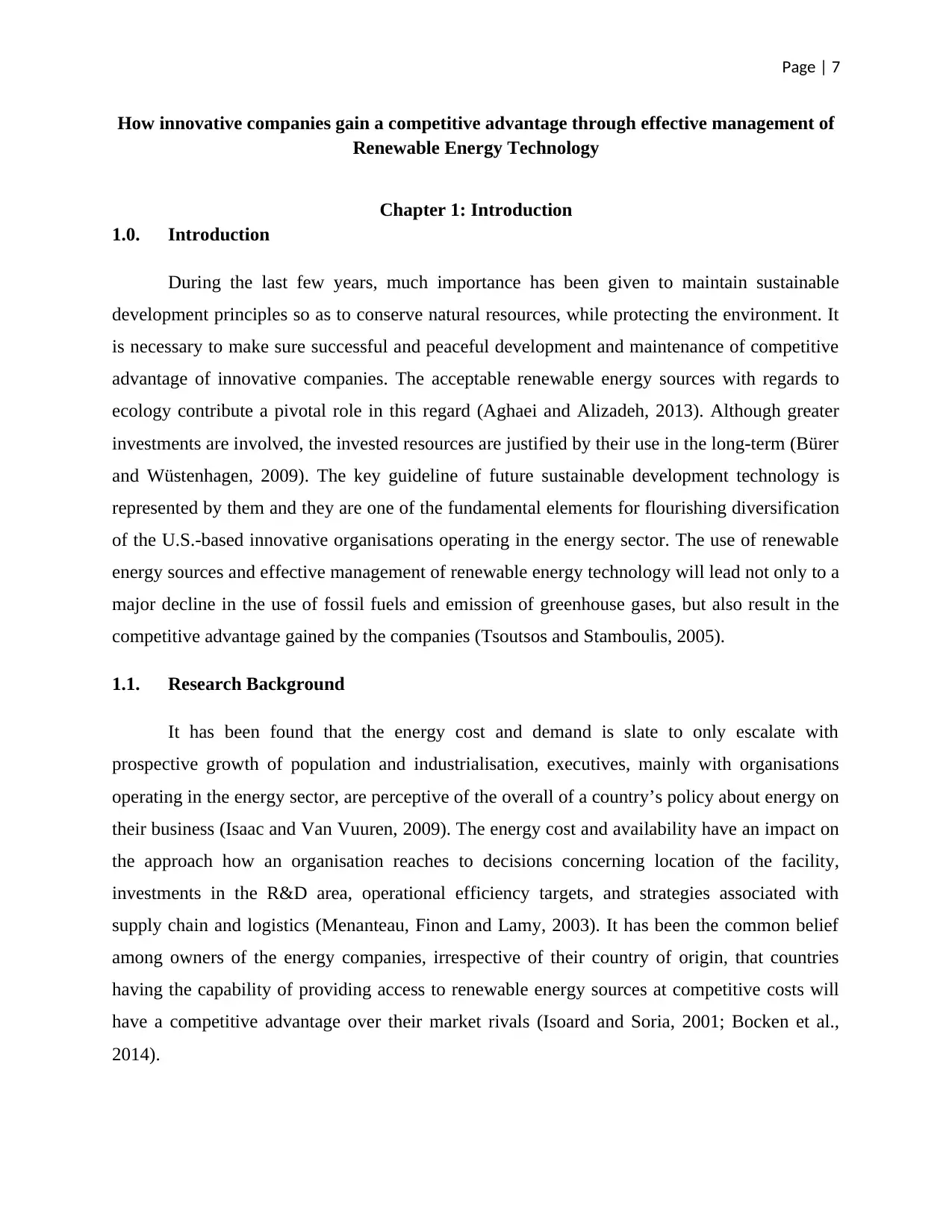
Page | 7
How innovative companies gain a competitive advantage through effective management of
Renewable Energy Technology
Chapter 1: Introduction
1.0. Introduction
During the last few years, much importance has been given to maintain sustainable
development principles so as to conserve natural resources, while protecting the environment. It
is necessary to make sure successful and peaceful development and maintenance of competitive
advantage of innovative companies. The acceptable renewable energy sources with regards to
ecology contribute a pivotal role in this regard (Aghaei and Alizadeh, 2013). Although greater
investments are involved, the invested resources are justified by their use in the long-term (Bürer
and Wüstenhagen, 2009). The key guideline of future sustainable development technology is
represented by them and they are one of the fundamental elements for flourishing diversification
of the U.S.-based innovative organisations operating in the energy sector. The use of renewable
energy sources and effective management of renewable energy technology will lead not only to a
major decline in the use of fossil fuels and emission of greenhouse gases, but also result in the
competitive advantage gained by the companies (Tsoutsos and Stamboulis, 2005).
1.1. Research Background
It has been found that the energy cost and demand is slate to only escalate with
prospective growth of population and industrialisation, executives, mainly with organisations
operating in the energy sector, are perceptive of the overall of a country’s policy about energy on
their business (Isaac and Van Vuuren, 2009). The energy cost and availability have an impact on
the approach how an organisation reaches to decisions concerning location of the facility,
investments in the R&D area, operational efficiency targets, and strategies associated with
supply chain and logistics (Menanteau, Finon and Lamy, 2003). It has been the common belief
among owners of the energy companies, irrespective of their country of origin, that countries
having the capability of providing access to renewable energy sources at competitive costs will
have a competitive advantage over their market rivals (Isoard and Soria, 2001; Bocken et al.,
2014).
How innovative companies gain a competitive advantage through effective management of
Renewable Energy Technology
Chapter 1: Introduction
1.0. Introduction
During the last few years, much importance has been given to maintain sustainable
development principles so as to conserve natural resources, while protecting the environment. It
is necessary to make sure successful and peaceful development and maintenance of competitive
advantage of innovative companies. The acceptable renewable energy sources with regards to
ecology contribute a pivotal role in this regard (Aghaei and Alizadeh, 2013). Although greater
investments are involved, the invested resources are justified by their use in the long-term (Bürer
and Wüstenhagen, 2009). The key guideline of future sustainable development technology is
represented by them and they are one of the fundamental elements for flourishing diversification
of the U.S.-based innovative organisations operating in the energy sector. The use of renewable
energy sources and effective management of renewable energy technology will lead not only to a
major decline in the use of fossil fuels and emission of greenhouse gases, but also result in the
competitive advantage gained by the companies (Tsoutsos and Stamboulis, 2005).
1.1. Research Background
It has been found that the energy cost and demand is slate to only escalate with
prospective growth of population and industrialisation, executives, mainly with organisations
operating in the energy sector, are perceptive of the overall of a country’s policy about energy on
their business (Isaac and Van Vuuren, 2009). The energy cost and availability have an impact on
the approach how an organisation reaches to decisions concerning location of the facility,
investments in the R&D area, operational efficiency targets, and strategies associated with
supply chain and logistics (Menanteau, Finon and Lamy, 2003). It has been the common belief
among owners of the energy companies, irrespective of their country of origin, that countries
having the capability of providing access to renewable energy sources at competitive costs will
have a competitive advantage over their market rivals (Isoard and Soria, 2001; Bocken et al.,
2014).
Paraphrase This Document
Need a fresh take? Get an instant paraphrase of this document with our AI Paraphraser

Page | 8
A leading force in investments, developing access for renewable energy and growing
energy efficiency at the national level are the development of electric transmission system
reliability and market access (Carrasco et al., 2006). Most of the well-developed countries have
electric transmission systems with open access, letting renewable connection and making them
able have connected national grids, an interconnected network through which electricity is
delivered from suppliers to consumers (Aghaei and Alizadeh, 2013). The demand for electric
energy in on the rise, thus it becomes more and more crucial for the energy sector to have a
connected grid.
Advancements in the technology (by means of renewable energy technologies) have the
great potential to reduce energy costs and enhance efficiency, not only for the policy related to
green investment (such as, wind or solar photovoltaics), but mainly in hydrocarbons including
natural gas hydraulic fracturing (Sawin, 2006; Chu and Majumdar, 2012). The growing reserves
of hydrocarbon, through more enhanced knowledge about geology and technology assisting in
managing and exploring, has immensely driven policy of energy for last few decades and is often
undervalued in potential impact (Chu and Majumdar, 2012). The “reserve” used as a term refers
simply the producible part of oil, meaning the total amount called the recovery factor. Across
different locations, a recovery factor can vary and alter with the passage of time on the basis of
operating history and changes in the technological or economic domains. As an instance, with
the passage of time a recovery factor might rise if highly improved technology-based techniques
are used for recovery, which include gas and surfactants injections, water-flooding, or microbial
enhanced oil recovery (Lloyd and Subbarao, 2009). In fact, new and innovative technologies
have escalated the precision of these techniques, there are still major uncertainties.
The demand for energy across the world is continuously growing regardless of the high
level of energy productivity achieved already by many countries including the U.S. Both
organisations and consumers will all acquire a lasting advantage related to cost by optimising the
overall energy efficiency of their products and processes. The costs of energy will increase in the
long term; present-day low prices of oil will rise again. If all known economic levers are pulled
by U.S. companies and households with the aim of increasing energy productivity, they can
lessen their costs of energy by up to $59 billion annually as of 2020 (de La Tour, Glachant and
A leading force in investments, developing access for renewable energy and growing
energy efficiency at the national level are the development of electric transmission system
reliability and market access (Carrasco et al., 2006). Most of the well-developed countries have
electric transmission systems with open access, letting renewable connection and making them
able have connected national grids, an interconnected network through which electricity is
delivered from suppliers to consumers (Aghaei and Alizadeh, 2013). The demand for electric
energy in on the rise, thus it becomes more and more crucial for the energy sector to have a
connected grid.
Advancements in the technology (by means of renewable energy technologies) have the
great potential to reduce energy costs and enhance efficiency, not only for the policy related to
green investment (such as, wind or solar photovoltaics), but mainly in hydrocarbons including
natural gas hydraulic fracturing (Sawin, 2006; Chu and Majumdar, 2012). The growing reserves
of hydrocarbon, through more enhanced knowledge about geology and technology assisting in
managing and exploring, has immensely driven policy of energy for last few decades and is often
undervalued in potential impact (Chu and Majumdar, 2012). The “reserve” used as a term refers
simply the producible part of oil, meaning the total amount called the recovery factor. Across
different locations, a recovery factor can vary and alter with the passage of time on the basis of
operating history and changes in the technological or economic domains. As an instance, with
the passage of time a recovery factor might rise if highly improved technology-based techniques
are used for recovery, which include gas and surfactants injections, water-flooding, or microbial
enhanced oil recovery (Lloyd and Subbarao, 2009). In fact, new and innovative technologies
have escalated the precision of these techniques, there are still major uncertainties.
The demand for energy across the world is continuously growing regardless of the high
level of energy productivity achieved already by many countries including the U.S. Both
organisations and consumers will all acquire a lasting advantage related to cost by optimising the
overall energy efficiency of their products and processes. The costs of energy will increase in the
long term; present-day low prices of oil will rise again. If all known economic levers are pulled
by U.S. companies and households with the aim of increasing energy productivity, they can
lessen their costs of energy by up to $59 billion annually as of 2020 (de La Tour, Glachant and

Page | 9
Ménière, 2013). In this regard, innovative companies in the U.S. could gain competitive
advantage by using and maintaining renewable energy technology.
1.2. Research Problem
The renewable energy sources are very expensive in relation to the traditional fossil-fuel
and nuclear sources used with the aim of generating electricity. For this very reason, all countries
have their own alternative programmes through which they promote renewable energy
technologies. Currently in the 21st century era, renewable energy sources based on technology
will rule the overall energy technology market. It seems that although renewable energy is very
costly, all the world’s countries, mainly their energy sector companies, are currently making
investment in research and development area with the aim of devising new and innovative
technologies and implementing them to make sure their competitive advantage (Peidong et al.,
2009). One of the key factors behind these are aspects associated with environment, fast growing
demand and cost of fossil fuel and reducing the risk of nuclear technologies (Peidong et al.,
2009). With these considerations in mind, this research work targets the energy sector companies
based in the United States to explore how they perceive the role played by of technological
innovations and advancements in the area of renewable energy in gaining competitive advantage.
1.3. Research Aim, Objectives and Questions
Defining its core aims, objectives and questions is an important task in any research
study. The core points in a research project are what central aim, goal or purpose of the research
project is and what research topics, questions and problems are (Ritchie et al., 2013). Majority of
the research projects have to face difficulty because not a considerable amount of time, effort and
thought is devoted while properly defining the research aims and goals. Consequently, valuable
time and authentic resources can be wasted gathering inappropriate research data. For this study,
following are the research aim, objective and questions:
1.3.1. Research Aim
The key aim and purpose of this research study is to explore and investigate the use and
management of renewable energy technology by companies operating in the energy sector and
how they gain competitive advantage through that. Keeping this aim in mind, the study has
Ménière, 2013). In this regard, innovative companies in the U.S. could gain competitive
advantage by using and maintaining renewable energy technology.
1.2. Research Problem
The renewable energy sources are very expensive in relation to the traditional fossil-fuel
and nuclear sources used with the aim of generating electricity. For this very reason, all countries
have their own alternative programmes through which they promote renewable energy
technologies. Currently in the 21st century era, renewable energy sources based on technology
will rule the overall energy technology market. It seems that although renewable energy is very
costly, all the world’s countries, mainly their energy sector companies, are currently making
investment in research and development area with the aim of devising new and innovative
technologies and implementing them to make sure their competitive advantage (Peidong et al.,
2009). One of the key factors behind these are aspects associated with environment, fast growing
demand and cost of fossil fuel and reducing the risk of nuclear technologies (Peidong et al.,
2009). With these considerations in mind, this research work targets the energy sector companies
based in the United States to explore how they perceive the role played by of technological
innovations and advancements in the area of renewable energy in gaining competitive advantage.
1.3. Research Aim, Objectives and Questions
Defining its core aims, objectives and questions is an important task in any research
study. The core points in a research project are what central aim, goal or purpose of the research
project is and what research topics, questions and problems are (Ritchie et al., 2013). Majority of
the research projects have to face difficulty because not a considerable amount of time, effort and
thought is devoted while properly defining the research aims and goals. Consequently, valuable
time and authentic resources can be wasted gathering inappropriate research data. For this study,
following are the research aim, objective and questions:
1.3.1. Research Aim
The key aim and purpose of this research study is to explore and investigate the use and
management of renewable energy technology by companies operating in the energy sector and
how they gain competitive advantage through that. Keeping this aim in mind, the study has
⊘ This is a preview!⊘
Do you want full access?
Subscribe today to unlock all pages.

Trusted by 1+ million students worldwide
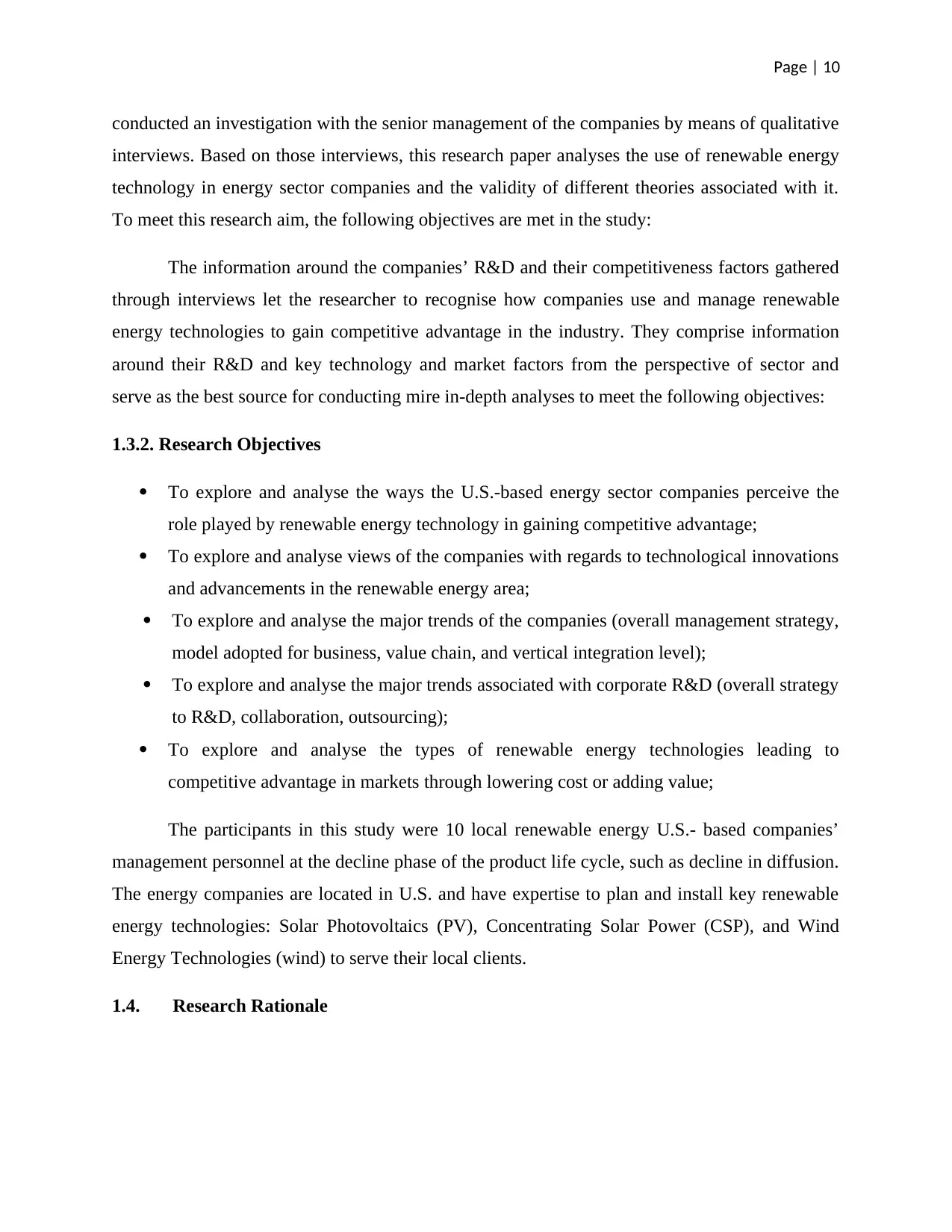
Page | 10
conducted an investigation with the senior management of the companies by means of qualitative
interviews. Based on those interviews, this research paper analyses the use of renewable energy
technology in energy sector companies and the validity of different theories associated with it.
To meet this research aim, the following objectives are met in the study:
The information around the companies’ R&D and their competitiveness factors gathered
through interviews let the researcher to recognise how companies use and manage renewable
energy technologies to gain competitive advantage in the industry. They comprise information
around their R&D and key technology and market factors from the perspective of sector and
serve as the best source for conducting mire in-depth analyses to meet the following objectives:
1.3.2. Research Objectives
To explore and analyse the ways the U.S.-based energy sector companies perceive the
role played by renewable energy technology in gaining competitive advantage;
To explore and analyse views of the companies with regards to technological innovations
and advancements in the renewable energy area;
To explore and analyse the major trends of the companies (overall management strategy,
model adopted for business, value chain, and vertical integration level);
To explore and analyse the major trends associated with corporate R&D (overall strategy
to R&D, collaboration, outsourcing);
To explore and analyse the types of renewable energy technologies leading to
competitive advantage in markets through lowering cost or adding value;
The participants in this study were 10 local renewable energy U.S.- based companies’
management personnel at the decline phase of the product life cycle, such as decline in diffusion.
The energy companies are located in U.S. and have expertise to plan and install key renewable
energy technologies: Solar Photovoltaics (PV), Concentrating Solar Power (CSP), and Wind
Energy Technologies (wind) to serve their local clients.
1.4. Research Rationale
conducted an investigation with the senior management of the companies by means of qualitative
interviews. Based on those interviews, this research paper analyses the use of renewable energy
technology in energy sector companies and the validity of different theories associated with it.
To meet this research aim, the following objectives are met in the study:
The information around the companies’ R&D and their competitiveness factors gathered
through interviews let the researcher to recognise how companies use and manage renewable
energy technologies to gain competitive advantage in the industry. They comprise information
around their R&D and key technology and market factors from the perspective of sector and
serve as the best source for conducting mire in-depth analyses to meet the following objectives:
1.3.2. Research Objectives
To explore and analyse the ways the U.S.-based energy sector companies perceive the
role played by renewable energy technology in gaining competitive advantage;
To explore and analyse views of the companies with regards to technological innovations
and advancements in the renewable energy area;
To explore and analyse the major trends of the companies (overall management strategy,
model adopted for business, value chain, and vertical integration level);
To explore and analyse the major trends associated with corporate R&D (overall strategy
to R&D, collaboration, outsourcing);
To explore and analyse the types of renewable energy technologies leading to
competitive advantage in markets through lowering cost or adding value;
The participants in this study were 10 local renewable energy U.S.- based companies’
management personnel at the decline phase of the product life cycle, such as decline in diffusion.
The energy companies are located in U.S. and have expertise to plan and install key renewable
energy technologies: Solar Photovoltaics (PV), Concentrating Solar Power (CSP), and Wind
Energy Technologies (wind) to serve their local clients.
1.4. Research Rationale
Paraphrase This Document
Need a fresh take? Get an instant paraphrase of this document with our AI Paraphraser
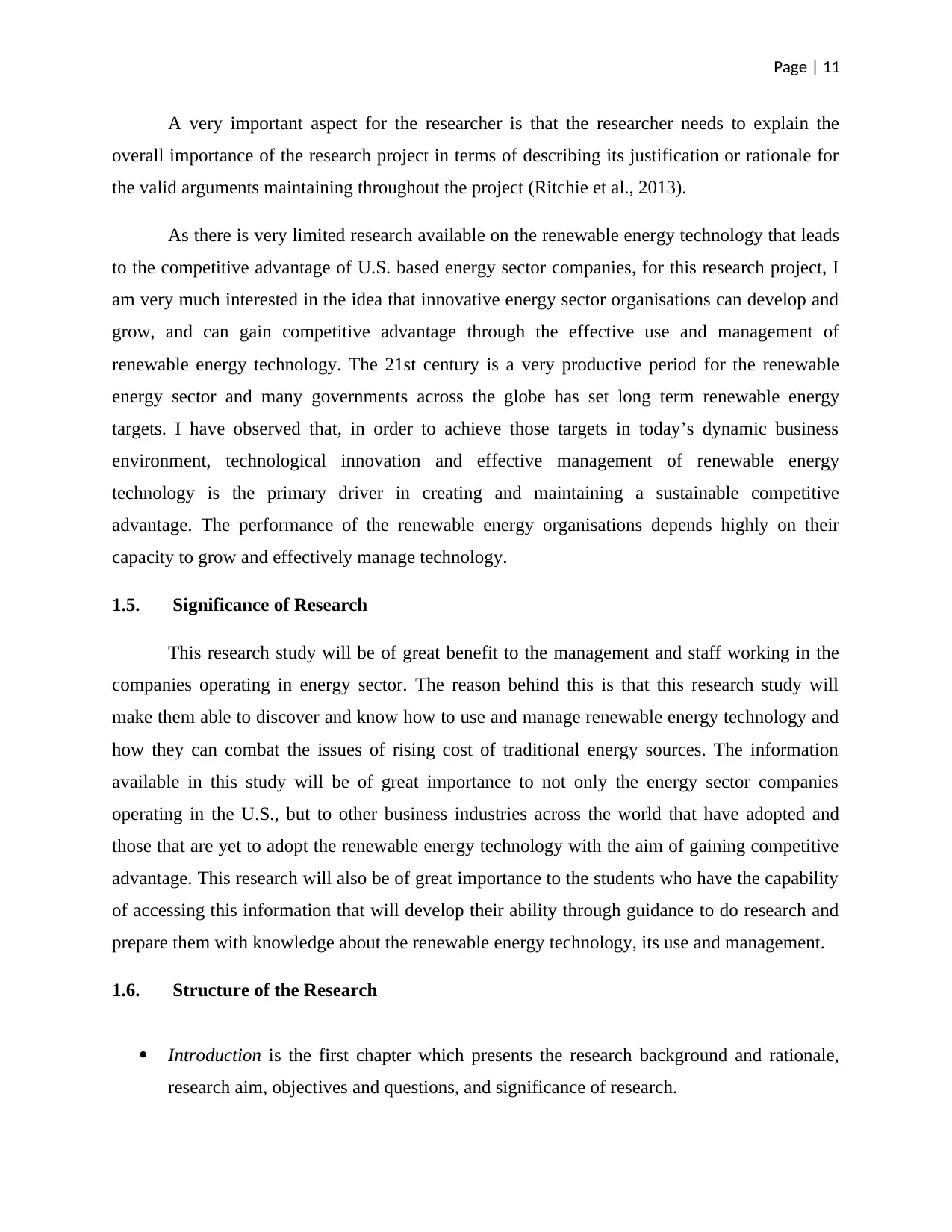
Page | 11
A very important aspect for the researcher is that the researcher needs to explain the
overall importance of the research project in terms of describing its justification or rationale for
the valid arguments maintaining throughout the project (Ritchie et al., 2013).
As there is very limited research available on the renewable energy technology that leads
to the competitive advantage of U.S. based energy sector companies, for this research project, I
am very much interested in the idea that innovative energy sector organisations can develop and
grow, and can gain competitive advantage through the effective use and management of
renewable energy technology. The 21st century is a very productive period for the renewable
energy sector and many governments across the globe has set long term renewable energy
targets. I have observed that, in order to achieve those targets in today’s dynamic business
environment, technological innovation and effective management of renewable energy
technology is the primary driver in creating and maintaining a sustainable competitive
advantage. The performance of the renewable energy organisations depends highly on their
capacity to grow and effectively manage technology.
1.5. Significance of Research
This research study will be of great benefit to the management and staff working in the
companies operating in energy sector. The reason behind this is that this research study will
make them able to discover and know how to use and manage renewable energy technology and
how they can combat the issues of rising cost of traditional energy sources. The information
available in this study will be of great importance to not only the energy sector companies
operating in the U.S., but to other business industries across the world that have adopted and
those that are yet to adopt the renewable energy technology with the aim of gaining competitive
advantage. This research will also be of great importance to the students who have the capability
of accessing this information that will develop their ability through guidance to do research and
prepare them with knowledge about the renewable energy technology, its use and management.
1.6. Structure of the Research
Introduction is the first chapter which presents the research background and rationale,
research aim, objectives and questions, and significance of research.
A very important aspect for the researcher is that the researcher needs to explain the
overall importance of the research project in terms of describing its justification or rationale for
the valid arguments maintaining throughout the project (Ritchie et al., 2013).
As there is very limited research available on the renewable energy technology that leads
to the competitive advantage of U.S. based energy sector companies, for this research project, I
am very much interested in the idea that innovative energy sector organisations can develop and
grow, and can gain competitive advantage through the effective use and management of
renewable energy technology. The 21st century is a very productive period for the renewable
energy sector and many governments across the globe has set long term renewable energy
targets. I have observed that, in order to achieve those targets in today’s dynamic business
environment, technological innovation and effective management of renewable energy
technology is the primary driver in creating and maintaining a sustainable competitive
advantage. The performance of the renewable energy organisations depends highly on their
capacity to grow and effectively manage technology.
1.5. Significance of Research
This research study will be of great benefit to the management and staff working in the
companies operating in energy sector. The reason behind this is that this research study will
make them able to discover and know how to use and manage renewable energy technology and
how they can combat the issues of rising cost of traditional energy sources. The information
available in this study will be of great importance to not only the energy sector companies
operating in the U.S., but to other business industries across the world that have adopted and
those that are yet to adopt the renewable energy technology with the aim of gaining competitive
advantage. This research will also be of great importance to the students who have the capability
of accessing this information that will develop their ability through guidance to do research and
prepare them with knowledge about the renewable energy technology, its use and management.
1.6. Structure of the Research
Introduction is the first chapter which presents the research background and rationale,
research aim, objectives and questions, and significance of research.

Page | 12
Literature Review is the second chapter in which the existing literature on the use and
management of renewable energy technology is reviewed. It suggests that this chapter
reviews the research studies conducted on how companies operating in the energy sector
can use and manage the various renewable energy technologies to gain, maintain and
improve their competitive advantage. Associated theoretical concepts and assumptions
are also presented that support the given arguments.
Research Methodology is the third chapter in which all the approaches and methods how
to collect data are presented. The main components of research methodology include the
overall research approach, research design and strategy, data collection approach, method
of sampling, and data analysis. For this, the study uses the Research Onion approach and
illustrates these components of research methodology thoroughly.
Results/ Findings is the fourth chapter in which main research and findings of the study
are presented.
Data Analysisand Discussion is the fifth chapter in which key understanding related to
the study is presented, along with in-depth analysis of the data obtained.
Conclusion and Recommendations is the sixth and last chapter in which overall summary
of the research study is presented, along with suitable recommendations for the
companies and for the future research need.
Literature Review is the second chapter in which the existing literature on the use and
management of renewable energy technology is reviewed. It suggests that this chapter
reviews the research studies conducted on how companies operating in the energy sector
can use and manage the various renewable energy technologies to gain, maintain and
improve their competitive advantage. Associated theoretical concepts and assumptions
are also presented that support the given arguments.
Research Methodology is the third chapter in which all the approaches and methods how
to collect data are presented. The main components of research methodology include the
overall research approach, research design and strategy, data collection approach, method
of sampling, and data analysis. For this, the study uses the Research Onion approach and
illustrates these components of research methodology thoroughly.
Results/ Findings is the fourth chapter in which main research and findings of the study
are presented.
Data Analysisand Discussion is the fifth chapter in which key understanding related to
the study is presented, along with in-depth analysis of the data obtained.
Conclusion and Recommendations is the sixth and last chapter in which overall summary
of the research study is presented, along with suitable recommendations for the
companies and for the future research need.
⊘ This is a preview!⊘
Do you want full access?
Subscribe today to unlock all pages.

Trusted by 1+ million students worldwide
1 out of 73
Related Documents
Your All-in-One AI-Powered Toolkit for Academic Success.
+13062052269
info@desklib.com
Available 24*7 on WhatsApp / Email
![[object Object]](/_next/static/media/star-bottom.7253800d.svg)
Unlock your academic potential
Copyright © 2020–2025 A2Z Services. All Rights Reserved. Developed and managed by ZUCOL.





